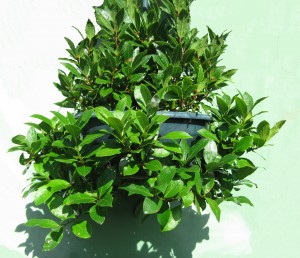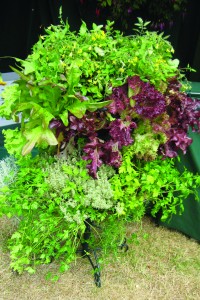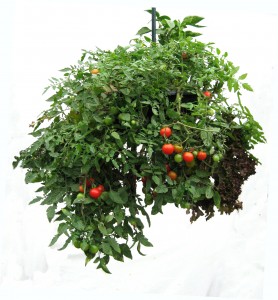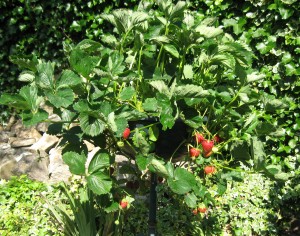Fruit and Veg
OUR CONTAINERS ARE JUST AS GOOD FOR VEGETABLES, HERBS AND STRAWBERRIES AS THEY ARE FOR FLOWERS. Modern high density housing does not provide much if any space for gardens but all you need with Dr Foster’s plant containers is a patch of patio or a sunny wall and you can grow something for the table. Because our baskets hold up to 18 plants you can get an awful lot of produce into a single container and if you really want to get into production you can fit a lot of containers into a very small space, particularly if you use vertical space such as a wall or fence post.
HERBS
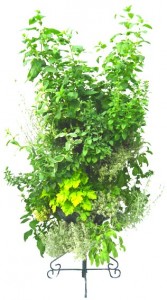 Herbs grow particularly well in our containers and as they are used in small quantities a single basket can keep you pretty much self sufficient for most of the year. If you use a 2 tier planter as illustrated you can grow as many as 36 plants in many varieties. In these baskets we have 3 of each of 12 different varieties. As well as being practical the different colours and variegations can make the baskets look very attractive. Plant those herbs that like dry conditions in the top and those that don’t mind a bit of moisture around the sides.
Herbs grow particularly well in our containers and as they are used in small quantities a single basket can keep you pretty much self sufficient for most of the year. If you use a 2 tier planter as illustrated you can grow as many as 36 plants in many varieties. In these baskets we have 3 of each of 12 different varieties. As well as being practical the different colours and variegations can make the baskets look very attractive. Plant those herbs that like dry conditions in the top and those that don’t mind a bit of moisture around the sides.
Perennial and shrub herbs such as Rosemary, Sage, Bay and Curry plants can be included together with annuals. Chose your favourites or try something new. Baskets can be planted in early April with plants from the garden centre or your own propagations or held over shrub herbs. Cropping can begin almost immediately and go on to the first frosts although some plants can be used all year long.
We would recommend that over the winter you dismantle the basket and remove the plants and roots. This will prevent the bully boys such as mints and lemon balm from crowding out the other plants. Divide where appropriate and pot up to over winter, replanting the baskets in spring when new shoots appear.
THE BAY BALL
The traditional bay ball is grown in a pot, cultivated as a standard plant, either singly or entwined in twos or threes and then clipped as topiary to form the ball. This takes many years. With Dr Foster’s containers the whole process is much quicker. The picture below taken in August shows a basket planted in May, only 3 months earlier, with 18 small inexpensive bay trees bought, as what the trade calls liners, in 4 inch pots. In just 3 months they have grown substantially and next spring clipping will begin so that after 18 months they will be taking shape either as a ball or cone. After 30 months you will have a mature Bay Ball which can easily be maintained through clipping. It will be much bigger than a traditional ball and be entirely portable, being able to be hung from a bracket, fixed on a wall or mounted on a stand. Of course bay is an important herb for cooking and throughout this process, from the date of planting, leaves can be picked for the kitchen.
This space will be updated with pictures as the bay ball progresses.
SALAD CROPS
The large capacity of our containers allows you to grow substantial quantities of salad crops in a single basket. A typical planting would be 10 cut and come again lettuces around the sides an three tumbling tomato plants in the top with maybe a beetroot or two as shown in the picture below. All can be grown from seed, potted on in 3 inch pots and put into the containers when established. If you use multi coloured lettuce types the result can be very attractive, even if you use just lettuce by itself. You can also use varieties of winter salad leaves in the same way for a longer season. As the plants are off the ground they are free of slugs and snails and do not get muddied by the rain. They can be positioned close to the kitchen door for convenience.
- Tumbling tom tomatoes ready to eat with side planting of lettuce.
STRAWBERRIES
Everybody’s favourite summer fruit. Our baskets hold 18 strawberry plants which is a lot of fruit in a very small space. You can use potted or bare root plants, either will do just as well. There are varieties specially developed for containers but you can uses pretty much any variety. As with salad crops your plants will be free of slugs and snails while fruit will remain clean and not rot off in wet soil. Strawberries are best kept for 3 years and then replaced. You can do this by potting up end of season runners from your third year ( or any year if you want more plants ) keeping to one or two runners per plant. Should any plant die or be poorly they can be replaced by simply pegging a new runner into the empty aperture and cutting the umbilical once it has become established. Use multi purpose compost with one part to four or five vermiculite or pearlite. Feed the plants with tomato food and keep the compost moist. Strawberries always crop better in their second and third years.

